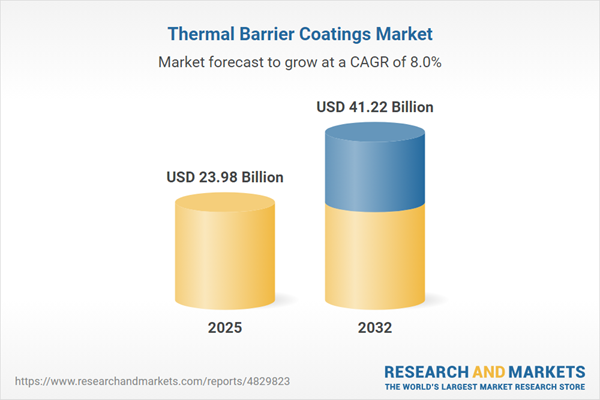Speak directly to the analyst to clarify any post sales queries you may have.
The thermal barrier coatings market is experiencing a significant transformation, fueled by intensifying performance demands in industrial and aerospace sectors. Senior decision-makers must stay ahead of evolving trends, technological advancements, and regulatory changes to safeguard competitiveness and maximize operational value.
Market Snapshot: Thermal Barrier Coatings Market Overview
The Thermal Barrier Coatings Market grew from USD 22.22 billion in 2024 to USD 23.98 billion in 2025. It is expected to continue growing at a CAGR of 8.02%, reaching USD 41.22 billion by 2032. This market expansion is propelled by rising investment in thermal management solutions, increased adoption in high-temperature environments, and collaborative development activities across global supply chains.
Scope & Segmentation
- Application Areas: Combustor, Exhaust Manifold, Turbine Blade, Turbine Vane
- Technology Platforms: Air Plasma Spray, Electron Beam Physical Vapor Deposition, High Velocity Oxy-Fuel
- Material Types: Mullite, Rare Earth Zirconate, Yttria Stabilized Zirconia
- End Use Industries: Aerospace (Business Jet, Commercial Aircraft, Military Aircraft), Automotive, Power Generation (Aero Gas Turbine, Industrial Gas Turbine)
- Process Stages: Aftermarket, OEM
- Regional Coverage: Americas (United States, Canada, Mexico, Brazil, Argentina, Chile, Colombia, Peru), Europe, Middle East & Africa (United Kingdom, Germany, France, Russia, Italy, Spain, Netherlands, Sweden, Poland, Switzerland, United Arab Emirates, Saudi Arabia, Qatar, Turkey, Israel, South Africa, Nigeria, Egypt, Kenya), Asia-Pacific (China, India, Japan, Australia, South Korea, Indonesia, Thailand, Malaysia, Singapore, Taiwan)
- Key Market Participants: A&A Thermal Spray Coatings, ASB Industries, Bodycote plc, Elmet Technologies, Howmet Aerospace Inc., IHI Corporation, Linde plc, OC Oerlikon Management AG, Saint-Gobain Coating Solutions SAS, Shin-Etsu Chemical Co., Ltd., TWI Ltd
Key Takeaways for Senior Decision-Makers
- Thermal barrier coatings have become integral for protecting components exposed to extreme heat and corrosive conditions, supporting higher efficiency and longer asset life cycles.
- Innovative deposition technologies and advanced ceramic chemistries are expanding the operational limits for applications in turbines, engines, and exhaust systems.
- Collaboration between original equipment manufacturers, suppliers, and research institutions accelerates innovation transfer and enables tailored solutions by region and sector.
- Strategic supply chain management, encompassing sourcing shifts and local partnerships, enhances resilience amid regulatory and market volatility.
- Aftermarket service models and digital solutions, such as predictive maintenance and real-time component monitoring, strengthen value propositions and recurring revenue opportunities.
Tariff Impact: Navigating Trade and Cost Pressures
Recent United States tariffs on imported thermal barrier coatings and raw materials have created new supply chain considerations. Producers confront increased acquisition costs and extended lead times, prompting a shift toward domestic sourcing and alternative material development to mitigate tariff exposure. These changes have accelerated innovation in local manufacturing and process optimization, shaping strategic responses within the coatings ecosystem.
Thermal Barrier Coatings Market: Methodology & Data Sources
This market research employs a multi-phase methodology grounded in primary interviews, technical workshops, and in-depth reviews of white papers, regulatory filings, and industry journals. Quantitative data were triangulated from secondary sources and validated through expert panel consultations, utilizing advanced analytical techniques to ensure actionable findings for senior stakeholders.
Why This Report Matters
- Enables leaders to benchmark thermal barrier coatings markets by technology, region, and application, supporting strategic investment and risk management decisions.
- Equips organizations to anticipate supply chain disruptions and leverage digital transformation for improved reliability and maintenance planning.
- Delivers a holistic outlook for aligning R&D, sourcing strategies, and commercial models with industry best practices in fast-evolving segments.
Conclusion
The thermal barrier coatings market continues to evolve through technological progress, shifting trade dynamics, and collaborative innovation. Organizations that align operational agility with robust supply networks and emerging digital capabilities are well positioned to capture new opportunities.
Additional Product Information:
- Purchase of this report includes 1 year online access with quarterly updates.
- This report can be updated on request. Please contact our Customer Experience team using the Ask a Question widget on our website.
Table of Contents
3. Executive Summary
4. Market Overview
7. Cumulative Impact of Artificial Intelligence 2025
Companies Mentioned
The companies profiled in this Thermal Barrier Coatings market report include:- A&A Thermal Spray Coatings
- ASB Industries
- Bodycote plc
- Elmet Technologies (formerly H.C. Starck Solutions)
- Howmet Aerospace Inc.
- IHI Corporation
- Linde plc
- OC Oerlikon Management AG
- Saint-Gobain Coating Solutions SAS
- Shin-Etsu Chemical Co., Ltd.
- TWI Ltd
Table Information
| Report Attribute | Details |
|---|---|
| No. of Pages | 182 |
| Published | November 2025 |
| Forecast Period | 2025 - 2032 |
| Estimated Market Value ( USD | $ 23.98 Billion |
| Forecasted Market Value ( USD | $ 41.22 Billion |
| Compound Annual Growth Rate | 8.0% |
| Regions Covered | Global |
| No. of Companies Mentioned | 12 |









